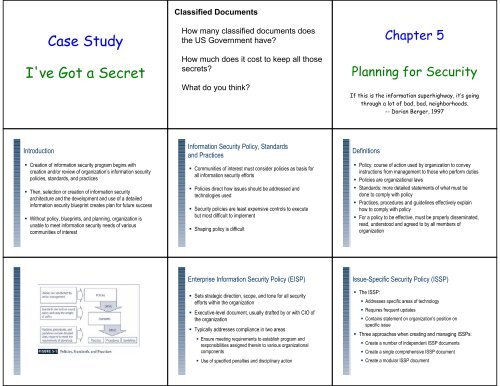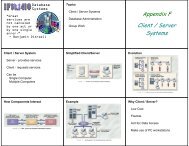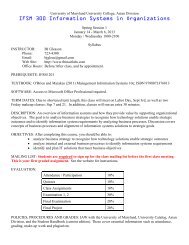Information and Security
Information and Security
Information and Security
You also want an ePaper? Increase the reach of your titles
YUMPU automatically turns print PDFs into web optimized ePapers that Google loves.
Case StudyI've Got a SecretClassified DocumentsHow many classified documents doesthe US Government have?How much does it cost to keep all thosesecrets?What do you think?Chapter 5Planning for <strong>Security</strong>If this is the information superhighway, it’s goingthrough a lot of bad, bad, neighborhoods.-- Dorian Berger, 1997Introduction Creation of information security program begins withcreation <strong>and</strong>/or review of organization’s information securitypolicies, st<strong>and</strong>ards, <strong>and</strong> practices Then, selection or creation of information securityarchitecture <strong>and</strong> the development <strong>and</strong> use of a detailedinformation security blueprint creates plan for future success Without policy, blueprints, <strong>and</strong> planning, organization isunable to meet information security needs of variouscommunities of interest<strong>Information</strong> <strong>Security</strong> Policy, St<strong>and</strong>ards<strong>and</strong> Practices Communities of interest must consider policies as basis forall information security efforts Policies direct how issues should be addressed <strong>and</strong>technologies used <strong>Security</strong> policies are least expensive controls to executebut most difficult to implement Shaping policy is difficultDefinitions Policy: course of action used by organization to conveyinstructions from management to those who perform duties Policies are organizational laws St<strong>and</strong>ards: more detailed statements of what must bedone to comply with policy Practices, procedures <strong>and</strong> guidelines effectively explainhow to comply with policy For a policy to be effective, must be properly disseminated,read, understood <strong>and</strong> agreed to by all members oforganizationEnterprise <strong>Information</strong> <strong>Security</strong> Policy (EISP) Sets strategic direction, scope, <strong>and</strong> tone for all securityefforts within the organization Executive-level document, usually drafted by or with CIO ofthe organization Typically addresses compliance in two areas Ensure meeting requirements to establish program <strong>and</strong>responsibilities assigned therein to various organizationalcomponents Use of specified penalties <strong>and</strong> disciplinary actionIssue-Specific <strong>Security</strong> Policy (ISSP) The ISSP: Addresses specific areas of technology Requires frequent updates Contains statement on organization’s position onspecific issue Three approaches when creating <strong>and</strong> managing ISSPs: Create a number of independent ISSP documents Create a single comprehensive ISSP document Create a modular ISSP document
















